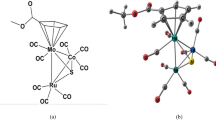Abstract
The chemical bonding manifolds in metal cluster skeletons (as well as in skeletons of clusters of other elements such as boron or carbon) may be classified according to their dimensionalities and their chemical homeomorphism to various geometric structures. The skeletal bonding manifolds of discrete metal cluster polyhedra may be either one-dimensional edge-localized or three-dimensional globally delocalized, although two-dimensional face-localized skeletal bonding manifolds are possible in a few cases. Electron precise globally delocalized metal cluster polyhedra withv vertices have 2v + 2 skeletal electrons and form deltahedra with no tetrahedral chambers having total skeletal bonding manifolds chemically homeomorphic to a closed ball. Electron-rich metal cluster polyhedra withv vertices have more than 2v + 2 skeletal electrons and form polyhedra with one or more non-triangular faces, whereas electron-poor metal cluster polyhedra withv vertices have less than 2v + 2 skeletal electrons and form deltahedra with one or more tetrahedral chambers. Fusion of metal cluster octahedra by sharing (triangular) faces forms three-dimensional analogues of polycyclic aromatic hydrocarbons such as naphthalene, anthracene, and perinaphthenide. Fusion of metal cluster octahedra by sharing edges can be extended infinitely into one and two dimensions forming chains (e.g. Gd2Cl3) and sheets (e.g. ZrCl), respectively. Infinite extension of such fusion of metal cluster octahedra into all three dimensions leads to bulk metal structures. Unusual anionic platinum carbonyl clusters can be contructed from stacks of Pt3 triangles or Pt5 pentagons. The resulting platinum polyhedra appear to exhibit edge-localized bonding, supplemented by unusual types of delocalized bonding at the top and the bottom of the stacks. Superconducting ternary molybdenum chalcogenides and lanthanide rhodium borides consist of infinite lattices of electronically linked edge-localized Mo6 octahedra or Rh4 tetrahedra, leading naturally to the idea of porous delocalization in superconducting materials.
Similar content being viewed by others
References
B.F.G. Johnson, ed.,Transition Metal Clusters (Wiley-Interscience, Chichester, England, 1980).
K. Wade, Chem. Commun. (1971) 792.
R.B. King and D.H. Rouvray, J. Amer. Chem. Soc. 99 (1977)7834.
R.B. King, Inorg. Chim. Acta 57 (1982)79.
R.B. King, in:Chemical Applications of Topology and Graph Theory, ed. R.B. King (Elsevier, Amsterdam, 1983) pp. 99–123.
R.B. King, in:Molecular Structure and Energetics, ed. J.F. Liebman and A. Greenberg (VCH, Deerfield Beach, Florida, 1986) pp. 123–148.
D.M.P. Mingos, Nature (London) Phys. Sci. 236 (1972)99.
K. Wade, Adv. Inorg. Chem. Radiochem. 18 (1976)1.
D.M.P. Mingos, Accts. Chem. Res. 17 (1984)311.
J.W. Lauber, J. Amer. Chem. Soc. 100 (1978)5305.
A.J. Stone, Inorg. Chem. 20 (1981)563.
A.J. Stone, Polyhedron 3 (1984)1299.
B.K. Teo, Inorg. Chem. 23 (1984)1251.
B.K. Teo, G. Longoni and F.R.K. Chung, Inorg. Chem. 23 (1984)1257.
B.K. Teo, Inorg. Chem. 24 (1985)115.
B.K. Teo, Inorg. Chem. 24 (1985)4209.
B. Grünbaum,Convex Polytopes (Intersience, New York, 1967).
R.B. King, J. Solid State Chem., in press.
R.B. King, J. Solid State Chem., in press.
M.J. Mansfield,Introduction to Topology (Van Nostrand, Princeton, 1963).
S.F.A. Kettle, Theor. Chim. Acta 3 (1965)282.
R.B. King, Inorg. Chim. Acta 129 (1987)91.
R.B. King, in:Mathematics and Computational Concepts in Chemistry, ed. N. Trinajstić (Harwood, Chichester, 1986) pp. 146–154.
R.B. King, Inorg. Chim. Acta 116 (1986)119.
R.W. Rudolph and W.R. Pretzer, Inorg. Chem. 11 (1972)1974.
R.W. Rudolph, Accts. Chem. Res. 9 (1976)446.
R.B. King, Int. J. Quant. Chem. 20S (1986)227.
R.B. King, Inorg. Chim. Acta 116 (1986)99.
D.W. Bullett, Inorg. Chem. 24 (1985)3319.
C. Kittel,Introduction to Solid State Physics, Third Edition (Wiley, New York, 1966) Chs. 7 and 8.
W.E. Dasent,Inorganic Energetics (Penguin Books, Lts., Baltimore, 1970).
H.E.N. Stone, Acta Metallurgica 27 (1979)259.
Ø. Fischer, M. Decroux, R. Chevrel and M. Sergent, in:Superconductivity in d- and f-Band Metals, ed. D.H. Douglas (Plenum Press, New York, 1976) pp. 176–177.
B.T. Matthias, M. Marezio, E. Corenzwit, A.S. Cooper and H.E. Barz, Science 175 (1972)1465.
S. Foner, E.J. McNiff, Jr. and E.J. Alexander, Phys. Lett. A49 (1974)269.
J.K. Burdett and J.-H. Lin, Inorg. Chem. 21 (1982)5.
Author information
Authors and Affiliations
Rights and permissions
About this article
Cite this article
King, R.B. The dimensionality and topology of chemical bonding manifolds in metal clusters and related compounds. J Math Chem 1, 249–265 (1987). https://doi.org/10.1007/BF01179793
Received:
Issue Date:
DOI: https://doi.org/10.1007/BF01179793




